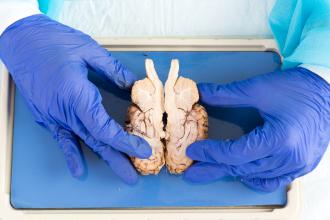I was accepted into UBC Medical School in 1951 with the proviso that I take a couple English courses in summer school. The admissions committee was satisfied with my science-oriented premed studies, but thought that with my Hungarian high school background I lacked appreciation of English literature. The first summer session course was focused on grammar, the second on literature, and in the literature course I was introduced to John Keats (1795–1821), the celebrated romantic poet of the early 1800s. I was astounded to learn that he was a doctor at age 20 but left his profession to become a poet. Why?
At age 14 Keats was apprenticed to the family’s doctor, Thomas Hammond. He learned to make medicines, clean the surgery, and prepare leeches to bleed patients. He then entered Guy’s Hospital as a medical student. He was one of 159 students to attend courses on anatomy and the operations of surgery, practice of medicine, theory of medicine and materia medica, the principles and practice of surgery, and experimental philosophy—the latter presenting the latest research by scientists. One must remember that at the time there was no anesthesia, no stethoscopes, no white coats or scrubs, and miasma was still thought to be the major etiological agent of most diseases.
He had a heavy schedule. In the early mornings he attended lectures in his various subjects. At 11 a.m. he would be dissecting in the anatomy rooms. In the afternoons he and fellow students would follow surgeons on their rounds, learning the art of diagnosis and postoperative care. One day per week he would attend admissions to the hospital to learn about assessment of patients. Around 8 p.m. there were lectures about the practice of surgery.
In his second year he was appointed dresser to one of the surgeons, a post like that of a modern-day resident in a specialty area. He assisted surgeons during operations, and he was responsible for pre- and postoperative care. He was on call nights to attend to emergencies. Medicine was a crude enterprise in many ways, and medical students of the time had a reputation for what one might call hard living. After a long day they often ventured out into London’s night life, and Keats was no exception.
In 1816, 5 years before his death, he received his Licentiate Certificate, which enabled him to practise as an apothecary and continue work for another year at Guy’s Hospital, but despite his busy schedule he was already deeply involved in writing his poems.
In 1817 Keats left his position as a dresser to make his career as a poet; unfortunately, by then his life was plagued by illness. He took cures fashionable at the time: sea bathing and fresh air at various coastal resorts. All he tried to live for was a state of mind that would help him create poetry. In February 1821, shortly after a “cure” on the Mediterranean, he died of tuberculosis in Rome.
It took me years to begin to appreciate Keats’ work, but it was only now, after reading an essay about him in a recent issue of the Lancet, that I began to understand why he left medicine to focus on poetry. In one of his unfinished poems he wrote: “a poet is a sage, / A humanist, a physician to all men.” In contrast to the crude realities of early 1800s medicine, poetry to him had the power to “pour out balm” on a troubled world. In a romantic age, to a romantic person, scientific explanations stole the mystery and wonder from beautiful phenomenon, such as a rainbow.
—George Szasz, CM, MD
Suggested reading
Bate J. John Keats in the season of mists. Lancet 2021;397(10280):1174-1175. https://www.thelancet.com/journals/lancet/article/PIIS0140-6736(21)00449-9/fulltext
Ruston S. John Keats, poet-physician. British Library. Discovering literature: Romantics and Victorians. Accessed 21 April 2021. www.bl.uk/romantics-and-victorians/articles/john-keats-poet-physician.
Ghosh H. John Keats’ medical notebook. Liverpool University Press. Accessed 21 April 2021. www.liverpooluniversitypress.co.uk/books/id/51580.
This post has not been peer reviewed by the BCMJ Editorial Board.


